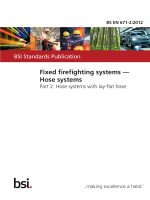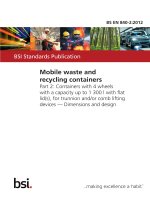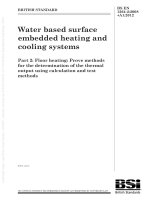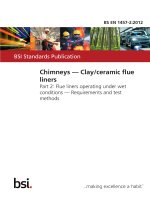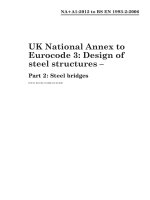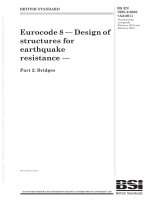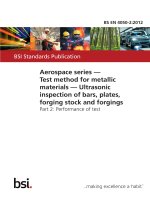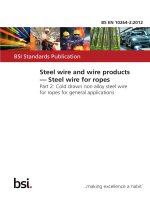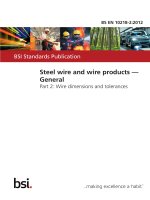Bsi bs en 61182 2 2 2012
Bạn đang xem bản rút gọn của tài liệu. Xem và tải ngay bản đầy đủ của tài liệu tại đây (1.85 MB, 48 trang )
BS EN 61182-2-2:2012
BSI Standards Publication
Printed board assembly
products — Manufacturing
description data and transfer
methodology
Part 2-2: Sectional requirements for
implementation of printed board
fabrication data description
NO COPYING WITHOUT BSI PERMISSION EXCEPT AS PERMITTED BY COPYRIGHT LAW
raising standards worldwide™
BRITISH STANDARD
BS EN 61182-2-2:2012
National foreword
This British Standard is the UK implementation of EN 61182-2-2:2012. It is
identical to IEC 61182-2-2:2012.
The UK participation in its preparation was entrusted to Technical Committee
EPL/501, Electronic assembly technology & Printed Electronics.
A list of organizations represented on this committee can be obtained on
request to its secretary.
This publication does not purport to include all the necessary provisions of a
contract. Users are responsible for its correct application.
© The British Standards Institution 2012
Published by BSI Standards Limited 2012
ISBN 978 0 580 70189 4
ICS 31.180
Compliance with a British Standard cannot confer immunity from
legal obligations.
This British Standard was published under the authority of the Standards
Policy and Strategy Committee on 31 August 2012.
Amendments issued since publication
Amd. No.
Date
Text affected
BS EN 61182-2-2:2012
EUROPEAN STANDARD
EN 61182-2-2
NORME EUROPÉENNE
June 2012
EUROPÄISCHE NORM
ICS 31.180
English version
Printed board assembly products Manufacturing description data and transfer methodology Part 2-2: Sectional requirements for implementation
of printed board fabrication data description
(IEC 61182-2-2:2012)
Produits pour cartes imprimées équipées Données descriptives de fabrication
et méthodologie de transfert Partie 2-2: Exigences intermédiaires pour
la mise en oeuvre de cartes imprimées Description des données de fabrication
(CEI 61182-2-2:2012)
Leiterplatten Beschreibung und Transfer von Daten Teil 2-2: Anforderungen für die
Anwendung von Dokumentationsdaten
der Leiterplattenfertigung
(IEC 61182-2-2:2012)
This European Standard was approved by CENELEC on 2012-06-01. CENELEC members are bound to comply
with the CEN/CENELEC Internal Regulations which stipulate the conditions for giving this European Standard
the status of a national standard without any alteration.
Up-to-date lists and bibliographical references concerning such national standards may be obtained on
application to the CEN-CENELEC Management Centre or to any CENELEC member.
This European Standard exists in three official versions (English, French, German). A version in any other
language made by translation under the responsibility of a CENELEC member into its own language and notified
to the CEN-CENELEC Management Centre has the same status as the official versions.
CENELEC members are the national electrotechnical committees of Austria, Belgium, Bulgaria, Croatia, Cyprus,
the Czech Republic, Denmark, Estonia, Finland, France, Germany, Greece, Hungary, Iceland, Ireland, Italy,
Latvia, Lithuania, Luxembourg, Malta, the Netherlands, Norway, Poland, Portugal, Romania, Slovakia, Slovenia,
Spain, Sweden, Switzerland, Turkey and the United Kingdom.
CENELEC
European Committee for Electrotechnical Standardization
Comité Européen de Normalisation Electrotechnique
Europäisches Komitee für Elektrotechnische Normung
Management Centre: Avenue Marnix 17, B - 1000 Brussels
© 2012 CENELEC -
All rights of exploitation in any form and by any means reserved worldwide for CENELEC members.
Ref. No. EN 61182-2-2:2012 E
BS EN 61182-2-2:2012
EN 61182-2-2:2012
-2-
Foreword
The text of document 91/1025/FDIS, future edition 1 of IEC 61182-2-2, prepared by IEC/TC 91
"Electronics assembly technology" was submitted to the IEC-CENELEC parallel vote and approved by
CENELEC as EN 61182-2-2:2012.
The following dates are fixed:
•
latest date by which the document has
to be implemented at national level by
publication of an identical national
standard or by endorsement
(dop)
2013-03-01
•
latest date by which the national
standards conflicting with the
document have to be withdrawn
(dow)
2015-06-01
Attention is drawn to the possibility that some of the elements of this document may be the subject of
patent rights. CENELEC [and/or CEN] shall not be held responsible for identifying any or all such
patent rights.
Endorsement notice
The text of the International Standard IEC 61182-2-2:2012 was approved by CENELEC as a
European Standard without any modification.
In the official version, for Bibliography, the following notes have to be added for the standards indicated:
IEC 61188-5-1
NOTE
Harmonised as EN 61188-5-1.
IEC 61188-5-2
NOTE
Harmonised as EN 61188-5-2.
IEC 61188-5-3
NOTE
Harmonised as EN 61188-5-3.
IEC 61188-5-4
NOTE
Harmonised as EN 61188-5-4.
IEC 61188-5-5
NOTE
Harmonised as EN 61188-5-5.
IEC 61188-5-6
NOTE
Harmonised as EN 61188-5-6.
IEC 61188-5-8
NOTE
Harmonised as EN 61188-5-8.
ISO 10303-210
NOTE
Harmonised as EN ISO 10303-210.
BS EN 61182-2-2:2012
EN 61182-2-2:2012
-3-
Annex ZA
(normative)
Normative references to international publications
with their corresponding European publications
The following documents, in whole or in part, are normatively referenced in this document and are
indispensable for its application. For dated references, only the edition cited applies. For undated
references, the latest edition of the referenced document (including any amendments) applies.
NOTE When an international publication has been modified by common modifications, indicated by (mod), the relevant EN/HD
applies.
Publication
Year
Title
EN/HD
Year
IEC 60194
-
Printed board design, manufacture and
assembly - Terms and definitions
EN 60194
-
IEC 61182-2
-
Printed board assembly products Manufacturing description data and transfer
methodology Part 2: Generic requirements
-
–2–
BS EN 61182-2-2:2012
61182-2-2 © IEC:2012
CONTENTS
1
Scope ............................................................................................................................... 6
2
Normative references ....................................................................................................... 6
3
Terms and definitions ....................................................................................................... 6
4
General principles ............................................................................................................ 7
5
4.1 Requirements .......................................................................................................... 7
4.2 Interpretation ........................................................................................................... 7
4.3 Categories and content ........................................................................................... 8
General rules.................................................................................................................... 9
5.1
5.2
5.3
5.4
5.5
5.6
5.7
5.8
5.9
5.10
5.11
5.12
5.13
Overview ................................................................................................................. 9
File content descriptions ........................................................................................ 10
Logistic descriptions .............................................................................................. 10
File history descriptions ......................................................................................... 10
5.4.1 General ..................................................................................................... 10
5.4.2 HistoryRecord use case – Initial design release ......................................... 11
5.4.3 Supply chain modifications ........................................................................ 12
5.4.4 OEM reviews modifications – HistoryRecord update .................................. 14
BOM (board fabrication materials) ......................................................................... 14
AVL (board material suppliers) .............................................................................. 16
Documentation layers ............................................................................................ 16
5.7.1 General ..................................................................................................... 16
5.7.2 Documentation layer restrictions ................................................................ 16
5.7.3 Reference to documentation ...................................................................... 17
5.7.4 Step usage ................................................................................................ 18
5.7.5 Set ............................................................................................................ 19
Design for excellence (Dfx) analysis ...................................................................... 19
5.8.1 General ..................................................................................................... 19
5.8.2 DfxMeasurement ....................................................................................... 19
Miscellaneous image layers ................................................................................... 19
5.9.1 General ..................................................................................................... 19
5.9.2 Step usage ................................................................................................ 20
Packages and land patterns .................................................................................. 20
5.10.1 General ..................................................................................................... 20
5.10.2 Step usage for component packages and land patterns ............................. 20
5.10.3 Land pattern details ................................................................................... 21
Solder mask and legend layers .............................................................................. 21
5.11.1 General ..................................................................................................... 21
5.11.2 Solder mask details ................................................................................... 21
5.11.3 Legend details ........................................................................................... 21
5.11.4 Step usage for solder mask and legend layers ........................................... 22
Drilling and routing (tooling) layers ........................................................................ 22
5.12.1 General ..................................................................................................... 22
5.12.2 Drilling details............................................................................................ 22
5.12.3 Routing details .......................................................................................... 22
5.12.4 Step usage for drilling and routing ............................................................. 23
Net list................................................................................................................... 23
BS EN 61182-2-2:2012
61182-2-2 © IEC:2012
–3–
6
5.13.1 General ..................................................................................................... 23
5.13.2 Step usage for net list ................................................................................ 24
5.14 Outer conductive layers ......................................................................................... 24
5.14.1 General ..................................................................................................... 24
5.14.2 Outer conductive layer details ................................................................... 24
5.14.3 Step usage for outer conductive layers ...................................................... 24
5.15 Inner conductive layers ......................................................................................... 25
5.15.1 Requirement .............................................................................................. 25
5.15.2 Inner conductive layer details .................................................................... 25
5.15.3 Step usage for inner conductive layers ...................................................... 25
5.16 Board construction ................................................................................................ 25
5.16.1 Requirement .............................................................................................. 25
5.16.2 Board construction details ......................................................................... 26
5.16.3 Step usage for board construction ............................................................. 26
Modeling ........................................................................................................................ 26
7
6.1 General ................................................................................................................. 26
6.2 Information models ................................................................................................ 27
Report generators .......................................................................................................... 28
8
7.1 IEC 61182-2-2 format ............................................................................................ 28
7.2 Hole usage report .................................................................................................. 29
7.3 Pad usage report ................................................................................................... 29
7.4 Conductor usage report ......................................................................................... 29
Glossary ......................................................................................................................... 29
Annex A (normative) Printed board fabrication schema ........................................................ 30
Bibliography .......................................................................................................................... 42
Figure 1 – Board fabrication data relationship ......................................................................... 9
Figure 2 – HistoryRecord use case ....................................................................................... 11
Figure 3 – Documentation package grade requirements ........................................................ 18
Figure 4 – Fabrication steps data model example ................................................................. 27
Figure 5 – IPC-2584 UML data model ................................................................................... 28
Table 1 – Function relationship of an IEC 61182-2-2 fabrication file ........................................ 8
Table 2 – Bom restrictions .................................................................................................... 15
Table 3 – Recommended reference designators for printed board material ........................... 15
Table 4 – Avl restrictions ...................................................................................................... 16
Table 5 – Documentation layer restrictions ........................................................................... 17
Table 6 – General descriptions of documentation layer functions .......................................... 17
Table 7 – Relationship to documentation standard ................................................................ 18
Table 8 – Miscellaneous layer restrictions ............................................................................. 20
–6–
BS EN 61182-2-2:2012
61182-2-2 © IEC:2012
PRINTED BOARD ASSEMBLY PRODUCTS –
MANUFACTURING DESCRIPTION DATA
AND TRANSFER METHODOLOGY –
Part 2-2: Sectional requirements for implementation
of printed board fabrication data description
1
Scope
This part of IEC 61182 provides the information on the manufacturing requirements used for
fabricating printed boards. This standard determines the XML schema details, defined in the
generic standard IEC 61182-2 and some of the sectional standards that are required to
accomplish the focused tasks. When other standards are invoked, their requirements become
a mandatory part of the fabrication details as defined in the IEC 61182-2.
The IEC 61182-2 contains all the requirements necessary to build an electronic product. The
cardinality indicated in the IEC 61182-2 may be superseded by a restriction of an attribute
(enumerated string ID) or indication of a requirement that is noted as being optional in the
generic standard. However, this standard renders the requirement mandatory based on the
supply chain communication need.
In order to assist the users of this standard, all the applicable XML schema elements that
apply to the board fabrication function are listed in Annex A. The list is grouped by topics and
shows the absolute path for the elements that pertain to the focus of this standard. If the
parent element is not present no children are considered in the implementation either.
However, all attributes identified for a particular element follow the cardinality of the
IEC 61182-2, unless a restriction is stated in this standard.
2
Normative references
The following documents, in whole or in part, are normatively referenced in this document and
are indispensable for its application. For dated references, only the edition cited applies. For
undated references, the latest edition of the referenced document (including any
amendments) applies.
IEC 60194,
Printed board design, manufacture and assembly – Terms and definitions
IEC 61182-2, Printed board assembly products – Manufacturing description data and
transfer methodology – Part 2: Generic requirements
3
Terms and definitions
For the purposes of this document, the terms and definitions of IEC 60194 as well as the
following apply.
3.1
data
intelligent information that may be used directly by machine in order to accomplish a
particular manufacturing event
BS EN 61182-2-2:2012
61182-2-2 © IEC:2012
–7–
3.2
drawings
hard copy or un-intelligent documentation (e.g. PDF) to which all formatting criteria apply
3.3
printed circuit board
PCB
composite of organic and inorganic material with external and internal wiring allowing
electronic components to be mechanically supported and electrically connected
3.4
supplier
organization or company responsible for providing the goods and/or services required to
produce an electronic product which includes physical items as well as intellectual/software
characteristics and is documented as either user procurement, supplier data or contractual
agreements
3.5
user
individual, organization, company or agency responsible for the procurement of
electrical/electronic hardware, and having the authority to define the class of equipment and
any variation or restrictions (i.e., the originator/custodian of the contract detailing these
requirements)
3.6
via
opening in the dielectric layer(s) through which a conductor passes upwards or downwards to
subsequent chip or package conductive layers for electrical interconnections or for heat
transfer
4
4.1
General principles
Requirements
The requirements of IEC 61182-2 are a mandatory part of this standard. The generic details
specifically provide data related to design, printed board manufacturing, assembly and test.
The XML schema of the IEC 61182-2 consists of four major functions each of which have
several children who then become new parent elements. Several of these major elements and
their associated new parents are defined in other sectional specifications, thus the
requirements of those standards are also a mandatory part of the board fabrication standard
to the extent of their description and any restrictions contained in this standard.
Each of the standards and the elements defined therein has a specific function or task
respectively, and although they may at times be used independently, they become an
important addition to the requirements of the board fabrication descriptions. As such the
following paragraphs provide the total requirements for the three types of board fabrication
files that are supported by the principles of the IEC 61182-2.
Accordingly, the information interchange for the specific purpose of printed board fabrication
is only possible if all the XML instances have been properly prepared for such a purpose.
4.2
Interpretation
"Shall", the emphatic form of the verb, is used throughout this standard whenever a
requirement is intended to express a provision that is mandatory. Deviation from a "shall"
requirement is not permitted, and compliance testing is required in order to demonstrate that
the XML instances are correct according to the W3C directives and this standard. The XML
–8–
BS EN 61182-2-2:2012
61182-2-2 © IEC:2012
schema shall be the method to check syntax and semantics. Any appropriate software tool
that prompts the user, to correct the ambiguity or to insert missing information, may be used
for this purpose.
The words "should" and "may" are used whenever it is necessary to express non-mandatory
provisions.
"Will" is used to express a declaration of purpose.
4.3
Categories and content
Table 1 provides the major functions that shall be addressed by this standard. The
descriptions relate to the appropriate printed board fabrication processes. There are fifteen
(15) unique functions that can be defined by the use of the XML elements and the resulting
XML instances.
Table 1 indicates the relationships of the requirements for various elements and topics within
the descriptions for a particular process.
Table 1 – Function relationship of an IEC 61182-2-2 fabrication file
Name
Fabrication
Comment and standard reference
1
2
3
File content descriptions
Logistic descriptions
File history descriptions
M
M
O
M
M
M
M
M
M
Elements indicated in IEC 61182-2 according to their
cardinality and restrictions of this standard.
BOM
AVL
M
–
M
M
M
M
Elements indicated in IEC 61182-2 according to their
cardinality and restrictions of this standard.
Miscellaneous image layers
Documentation layers
Design for excellence (Dfx) analysis
–
O
O
O
M
O
O
M
O
Elements indicated in IEC 61182-2 according to their
cardinality and restrictions of this standard.
Component packages a
Land patterns a
Soldermask, legend layers
Drilling and Routing (tooling) layers
Net list (soft tooling) a
Outer conductive layers
Inner conductive layers
Board construction
Abbreviations:
BOM
Board fabrication materials
AVL
Board material suppliers
Dfx
Design for eXcellence
–
–
M
M
O
M
M
M
–
–
M
M
M
M
M
M
O
O
M
M
M
M
M
M
Elements indicated in this sectional standard, according to
cardinality of IEC 61182-2 and any restrictions contained
in the following paragraphs of this standard.
Key:
M
O
–
Mandadory
Optional (may or may not be pertinent to the particular file or data interchange)
Extraneous section (not necessary)
Although software tools used to parse the file will permit the extraneous data, it is recommended that only the requirements
identified as mandatory or optional are included in the file in order to reduce file size transfer.
a
Component packages and land patterns will be further defined in future IEC 61182-2-3 1, and net lists in future
IEC 61182-2-4 1 , their XML schemas are repeated in this standard.
—————————
1 Under consideration
BS EN 61182-2-2:2012
61182-2-2 © IEC:2012
–9–
It should be understood that without a net list it is difficult to verify that the produced board
meets the design intent.
The correlation between the various descriptions identified in this standard is indicated in
Figure 1. It shows the relationship of test coupons, individual board, phototools, etc. The
illustration identifies those characteristics that are available in the CAD tools and are usually
transferable to the CAM station. The left hand side illustrates combinations of the design
intent including assembly characteristics and embedded components. Some of these
concepts are important for IEC 61182-2-2 FAB1, FAB2 or FAB3 file and are illustrated for the
board manufacturing processes shown on the right hand side of the illustration.
IEC 630/12
Figure 1 – Board fabrication data relationship
5
5.1
General rules
Overview
The following details reflect the rules used in describing the printed board characteristics in
order to meet the requirements for board fabrication. These rules are intended to meet the
needs of the manufacturer to understand the customer requirements. Wherever necessary,
additional requirements have been detailed to reflect precision.
The attributes and rules described in IEC 61182-2 are required. Wherever necessary, detailed
descriptions or definitions of the entities, attributes or characteristics are reproduced as
defined in IEC 61182-2 in an attempt to clearly define the mandatory descriptions.
– 10 –
5.2
BS EN 61182-2-2:2012
61182-2-2 © IEC:2012
File content descriptions
The file content descriptions shall be in accordance with IEC 61182-2. This is a mandatory
requirement for all FAB layers, FAB1, FAB2, and FAB3.
The only restriction in Content is that a BomRef is mandatory (1-1). A Bom for board material
description will appear in the future IEC 61182-2-1 2 file.
IEC 61182-2/Content/BomNameRef=1
5.3
Logistic descriptions
All requirements for the logistic descriptions shall be in accordance with IEC 61182-2. The
only restriction being if the file will be used as a transfer of information outside the domain
that creates the file. In this case, the RoleRef attribute of Person shall exist and is no longer
optional.
IEC 61182-2/LogisticHeader/Person@RoleRef=1
It is required that the Role name be one of the 9 enumerated strings listed in IEC 61182-2
with a recommendation that if no other obvious name exists, the name SENDER should be
used.
IEC 61182-2/LogisticHeader/Role@name=SENDER
It should be understood that the sender of the file may not actually have electronic means to
add data or modify the existing XML schema instance. If a dialog occurs between the sender
and receiver of the data, verification should be made to establish file hierarchy and
modification capability at either end.
5.4
5.4.1
File history descriptions
General
All requirements for the history descriptions are in accordance with IEC 61182-2. The
restrictions are slightly different for the various fabrication levels and pertain to:
FAB1 has no restrictions and meets all requirements of IEC 61182-2.
FAB2 takes the changeRecord and makes it a mandatory requirement (1-n instead of 0-n).
FAB3 requires that changeRecord and the Approval element are a mandatory part of the
instance file.
IEC 61182-2/HistoryRecord/ChangeRec=1-n
IEC 61182-2/HistoryRecord/ChangeRec/Approval=1-n
Figure 2 provides a case study of the HistoryRecord. Figure 2 and subsequent subclauses
show the trend in communication between design at the OEM level and manufacturing.
—————————
2 Under consideration.
BS EN 61182-2-2:2012
61182-2-2 © IEC:2012
– 11 –
ECN Design
ECAD Design
Complete
"2004-02-11T12:53">
certificationCategory = "DETAILEDDRAWING/">
</FileRevision>
</HistoryRecord>
OEM creates Initial 2581
file
Agreement
on changes
reached?
1
OEM reads updated 2581
file and reviews changes
OEM releases 2581 file to
Fabricator
2
OEM
accepts
changes?
FAB
House
changes
the data?
End
No
Yes
FAB House writes an
updated 2581 file
Fabricator sends
updated 2581 file to OEM
"2004-02-11T12:53">
</SoftwarePackage>
</FileRevision>
reflecting
changes required by Fabrication supplier"/>
</HistoryRecord>
1
Yes
OEM creates updated
2581 file
OEM releases updated
2581 file to Fabricator
2
OEM notifies supplier that change was
not accepted and negotiates resolution
This could result in this process
returning to beginning at ECAD Design
Complete or continuing on with an
updated 2581 file detailing agreed upon
change via a ChangeRec
No
software = "ECAD Design Tool" lastChange =
"2004-02-14T10:02">
revision = "987.654">
</SoftwarePackage>
</FileRevision>
application = "Immediately" change = "Update to
database reflecting
changes required by Fabrication supplier">
</ChangeRec>
</HistoryRecord>
IEC 631/12
Figure 2 – HistoryRecord use case
5.4.2
5.4.2.1
HistoryRecord use case – Initial design release
General
The EDA design tool creates the initial IEC 61182-2 file is with the LogisticHeader,
HistoryRecord and the HistoryRecord child FileRevision elements.
5.4.2.2
LogisticHeader
The LogisticHeader contains the contact information for the OEM personnel who have defined
roles for the design project. There are many methods for getting contact information into the
EDA tool for export to an IEC 61182-2 file. These methods will range from manual
manipulation such as using a dynamic dialog box to automatically importing from a
contacts.xml file or corporate database.
The Role name and Person name shall be unique names. The Person name may be an
actual name, such as John Smith; title, such as senior designer, or department name, such as
purchasing department.
Ideally, the ability to import all preferred supplier information from external sources will be
available in order to include preferred suppliers in the LogisticHeader element. Below is a
sample of the minimum data necessary for a complete LogisticHeader element with
optional fields populated.
<LogisticHeader>
– 12 –
BS EN 61182-2-2:2012
61182-2-2 © IEC:2012
purchasing agent"/>
"Bigcity" stateProvince = "PV" country = "US" postalCode
= "99999-1111" phone = "888-555-1212" fax = "888-5551212" email="" url =
"" />
"" phone = "888-555-1212ext123"
fax = "888-555-1212" roleRef = "OEM Account Manager "/>
<Logistic Header>
5.4.2.3
HistoryRecord
The HistoryRecord is the location of log type information for maintaining revision control of
the IEC 61182-2 file for a design's life cycle. This does not mean that the entire history is
present in any IEC 61182-2 file. It gives the OWNER a data record, which could be exported
to a corporate database.
The EDA tool shall create a HistoryRecord for each IEC 61182-2 file by providing a means
to enter the HistoryRecord number and the FileRevision fileRevisionID. This data
could be entered by manual manipulation such as using a dynamic dialog box.
</SoftwarePackage>
</FileRevision>
</HistoryRecord>
5.4.3
5.4.3.1
Supply chain modifications
General
A modification is added to the initial IEC 61182-2 file by a member of the supply chain. This
modification can be as simple as adding a test coupon or panelizing the board to finding
problems with the design and requiring design modification in order to produce a finish board.
5.4.3.2
LogisticHeader update
In order to add the ChangeRec to the HistoryRecord, the supply chain may need to update
the LogisticHeader with additional information to provide the Role, Enterprise and
Person data for the supply chain.
BS EN 61182-2-2:2012
61182-2-2 © IEC:2012
– 13 –
The supplier shall not modify the information associated with any enterprise id other than their
own. Updating the LogisticHeader shall create a ChangeRec even if no other data was
modified. This will provide the means for the OEM to update their contacts information.
There are many methods for getting this information into the file that range from manual
manipulation to importing a contacts.xml. Below is a sample of a contacts.xml file.
<LogisticHeader>
"Bigcity" stateProvince = "PV" country = "US" postalCode
= "99999-1111" phone = "888-555-1212" fax = "888-5551212" email="" url =
"" />
purchasing agent"/>
"" phone = "888-555-1212ext123"
fax = "888-555-1212" roleRef = "OEM Account Manager "/>
"Mytown" stateProvince = "ST" country = "US" postalCode =
"00000-1111" phone = "800-555-1212" fax = "800-555-1212"
email="" url =
"" />
"x6d8rf7xd90mJHR13" authority = "Feed back to OEM"/>
"FAB Lead Engineer"/>
"" phone = "800-5551212ext123" fax = "800-555-1212" roleRef = "Supply Chain
Customer Account Manager "/>
"" phone = "800-5551212ext456" fax = "800-555-1212" roleRef = " FAB Project
Lead Engineer "/>
<Logistic Header>
5.4.3.3
HistoryRecord update
The HistoryRecord parent shall remain unchanged by the supply chain’s software. It is
identified in the example by the use of underlined text. The supply chain’s software uses the
FileRevision to identify the software used to create the updated IEC 61182-2 file.
– 14 –
BS EN 61182-2-2:2012
61182-2-2 © IEC:2012
manufacturing requirements">
</SoftwarePackage>
</FileRevision>
reflecting
changes required by fabrication process."/>
</HistoryRecord>
5.4.4
OEM reviews modifications – HistoryRecord update
The OEM and their supply chain can use the fileRevisionID to match IEC 61182-2 files to
their predecessors. Maintaining consistency in the fileRevisionID field will facilitate the
ability to reuse items during the design’s lifecycle.
</SoftwarePackage>
</FileRevision>
reflecting
changes required by Fabrication supplier">
</ChangeRec>
</HistoryRecord>
5.5
BOM (board fabrication materials)
The BOM layer requirements shall be in accordance with IEC 61182-2. The following
restrictions apply:
Bom/BomItem@category=MATERIAL
This is a mandatory requirement for FAB1, FAB2, and FAB3. Table 2 shows the Bom
restrictions for board fabrication.
BS EN 61182-2-2:2012
61182-2-2 © IEC:2012
– 15 –
Table 2 – Bom restrictions
Content/FunctionMode
FunctionModeType
@mode=
FABRICATION
@level=1
@mode=
FABRICATION
@level=2
@mode=
FABRICATION
@level=3
@category=MATERIAL
@category=MATERIAL
@category=MATERIAL
Bom/BomItem
BomItemType
Bom/BomItem/RefDes.
RefDesType
Per Table 3
Per Table 3
Per Table 3
Bom/BomItem/RefDes/
Tuning
TuningType
0
0
0
Bom/BomItem/RefDes/
Firmware
FirmwareType
0
0
0
Bom/BomItem/RefDes/
Firmware/File
FileType
0
0
0
Bom/BomItem/RefDes/
Firmware/CachedFirmware
CachedFirmware
Type
0
0
0
Bom/BomItem/RefDes/
Firmware/FirmwareRef
FirmwareRefType
0
0
0
Bom/BomItem/
Characteristics
CharacteristicsType
@category=MATERIAL
@category=MATERIAL
@category=MATERIAL
Bom/BomItem/
Characteristics/
Measured
MeasuredType
IEC 61182-2
1-n
1-n
Bom/BomItem/Characterist
ics/
Ranged
RangedType
IEC 61182-2
IEC 61182-2
1-n
When reference designators are required, as indicated for BomItem, the RefDes shall be in
accordance with Table 3. Since the RefDes element is normally restricted to electronic
components, this table has been constructed as a recommended methodology for defining
different materials within the Bom. RefDes has a 1-n cardinality requirement. This is still
appropriate for FAB1, FAB2, and FAB3. When the RefDes element is instanced, the attribute
name shall be in accordance with Table 3.
IEC 61182-2/Bom/BomItem/RefDes@name=Table 3
Table 3 – Recommended reference designators for printed board material
Material type
Reference designator
Legend ink
LEG
Soldermask
SDM
Conductor
CND
Dielectric base material
DBM
Dielectric core
DIC
Dielectric prepreg
DPP
Dielectric adhesive
DIA
Solder bump
SBM
Hole fill material
HFM
Resistive material
ERM
Capacitive material
ECM
Other
OTH
Comments
Additional restrictions for BomItem are that the Category attribute shall be listed as
MATERIAL.
BS EN 61182-2-2:2012
61182-2-2 © IEC:2012
– 16 –
IEC 61182-2/Bom/BomItem@category=MATERIAL
The Characteristic element also has some restrictions that pertain to FAB2 and FAB3.
These relate to the occurrence of the Measured and Ranged elements which become
mandatory in certain applications.
IEC 61182-2/Bom/BomItem/Characteristic@category=MATERIAL (same as BomItem)
IEC 61182-2/Bom/BomItem/Characteristic/Measured=1 (for FAB2 and FAB3)
IEC 61182-2/Bom/BomItem/Characteristic/Ranged=1 (for FAB3)
5.6
AVL (board material suppliers)
The AVL requirements shall be in accordance with IEC 61182-2. The following restrictions
apply and are detailed in Table 4:
Avl/AvlHeader@modRef=FABRICATION
This is an optional requirement for FAB2 and FAB3.
Table 4 – Avl restrictions
Avl/AvlHeader
AvlHeaderType
Avl/AvlItem
AvlItemType
@modRef=
FABRICATION
@modRef=
FABRICATION
1-1
1-1
@qualified=FALSE or
TRUE
@chosen=FALSE or
TRUE
Avl/AvlItem/AvlV
mpn
AvlVmpnType
Avl/AvlItem/AvlV
mpn/AvlMpn
AvlMpnType
0-1
0-1
0-1
Avl/AvlItem/AvlV
mpn/AvlVendor
AvlVendorType
0-1
0-1
0-1
5.7
5.7.1
@qualified=FALSE
@chosen=FALSE
1-1
@qualified=FALSEor
TRUE
@chosen=FALSE or
TRUE
@modRef=
FABRICATION
Documentation layers
General
The documentation layer requirements shall be in accordance with IEC 61182-2. The
following restrictions apply:
Ecad/CadData/Layer@LayerFunction=DOCUMENTATION
Ecad/CadData/Layer@name=unique layer name recommended consistent with Step name
This is a mandatory requirement for FAB1, FAB2 and FAB3.
5.7.2
Documentation layer restrictions
The following functions shown in Table 5 are applicable when a documentation layer is
identified.
BS EN 61182-2-2:2012
61182-2-2 © IEC:2012
– 17 –
Table 5 – Documentation layer restrictions
Content/Function
Mode
FunctionMode
Type
@mode=FABRICATION
@mode=FABRICATION
@mode=FABRICATION
@level=1
@level=2
@level=3
Ecad/CadData/
Layer
LayerType
@layerFunction=COURTYARD
@layerFunction=COURTYARD
@layerFunction=COURTYARD
@layerFunction=GRAPHIC
@layerFunction=GRAPHIC
@layerFunction=GRAPHIC
@layerFunction=DRAWING
@layerFunction=DRAWING
@layerFunction=DRAWING
@layerFunction=LANDPATTERN
@layerFunction=LANDPATTERN
@layerFunction=LANDPATTERN
@layerFunction=COMPONENT_
TOP
@layerFunction=COMPONENT_
TOP
@layerFunction=COMPONENT_
TOP
@layerFunction=COMPONENT_
BOTTOM
@layerFunction=COMPONENT_
BOTTOM
@layerFunction=COMPONENT_
BOTTOM
@layerFunction=OTHER
@layerFunction=OTHER
@layerFunction=OTHER
Key:
italics = optional
To facilitate the interpretation, Table 6 provides a reference illustration table of those
restrictions shown in their XML path description in Table 5.
Table 6 – General descriptions of documentation layer functions
@layerFunction
FAB1
FAB2
FAB3
COURTYARD
O
O
O
GRAPHIC
O
O
O
DRAWING
O
M
M
LANDPATTERN
O
O
O
COMPONENT_TOP
O
M
M
Only applies to assembly documentation
COMPONENT_BOTTOM
O
M
M
Only applies to assembly documentation
OTHER
O
O
O
5.7.3
Remarks
Used mostly for any form of
documentation
Reference to documentation
The information in Table 7 highlights the documentation functions for the IEC 61182-2
standard. This information shall be consistent throughout the data file.
Figure 3 provides an illustration indicating an approximate variation in the degree of mixture
between electronic and hard copy documentation. Electronic documentation is considered
non-intelligent (ready for printing a hard copy), while data is considered intelligent (ready for
machine usage).
BS EN 61182-2-2:2012
61182-2-2 © IEC:2012
– 18 –
IEC 632/12
Figure 3 – Documentation package grade requirements
Since the documentation requirment has three grades (A, B, C), plus three levels of
complexity in each grade (1, 2, 3), a correlation should be established between the particular
grade levels and the data documentation in an IEC 61182-2-2 file, see Table 7.
Table 7 – Relationship to documentation standard
Complexity/Grade
A
B
C
1
N/A
FAB1, FAB2
FAB1, FAB2
2
N/A
FAB1, FAB2, FAB3
FAB1, FAB2, FAB3
3
N/A
FAB2, FAB3
FAB2, FAB3
Grade B will fail the automated use case validation and needs to be manually validated. The
goal is to strive for Grade C documentation when using the IEC 61182-2 to accommodate a
60 % to 100 % data transfer.
5.7.4
5.7.4.1
Step usage
Step element
The Step element is used several times when Layer is used for documentation. Each Step
has a Step name. It is recommended that the Step name assigned to the Step be unique
and be similar to the name attribute assigned for layer. The LayerFunction shall be
DOCUMENTATION types, see Table 5.
5.7.4.2
Step
There may be one to many "Step"s in any IEC 61182-2-2 file. Each Step has a unique name,
which may be anything but is recommended to be an identifiable subset of the Step, and
should be in accordance with the attribute Step/name.
It should be noted that some "Step"s for documentation take advantage of previously
defined "Step"s (i.e. taking a board step and an assembly step to make an assembly
BS EN 61182-2-2:2012
61182-2-2 © IEC:2012
– 19 –
drawing. This would use the StepRepeat element to combine previously defined "Step"s by
placing the graphical images on a drawing format.
Each Step requires a mandatory definition for Datum and Profile. All graphical information
shall be provided as a LayerFeature.
When LayerFeature defines the graphical information using the various “Set”s, it shall be
associated with the specific layer as identified by the layer name. This is accomplished
through the mandatory layerRef associated with the LayerFeature of any Step within any
IEC 61182-2-2 file.
Step/LayerFeature@layerRef=Layer@name (unique user assigned)
5.7.5
Set
All documentation requirements shown in Table 1 shall be pre-defined in the user dictionary
section of the file and will be instanced through the path:
Ecad/CadData/Step/LayerFeature/Set/Features
When documentation features are instanced at the time the feature is described, the
lineDescGroup associated with the specific feature (Line, Arc, Polyline, and Outline) shall
take precedence and the lineDescGroup of Set shall be 0.
5.8
5.8.1
Design for excellence (Dfx) analysis
General
All characteristics for DfxMeasurement shall be in accordance with IEC 61182-2. When Dfx
analysis is required as defined in Table 1, the DfxMeasurementList shall restrict the
category to BOARDFAB.
Ecad/CadData/Step/DfxMeasurementList@category=BOARDFAB
This is a mandatory requirement for FAB2 and FAB3.
5.8.2
DfxMeasurement
When DfxMeasurement characteristics are instanced at the time the feature is described,
the lineDescGroup associated with the specific feature (Line, Arc, Polyline, and Outline)
shall take precedence and the lineDescGroup of Set shall be 0.
5.9
5.9.1
Miscellaneous image layers
General
Miscellaneous image layers are used primarily to capture and transfer graphical descriptions
that do not necessarily belong in any of the specific categories of the CadData descriptions.
This layer’s requirements shall be in accordance with IEC 61182-2. The following restrictions
apply:
Ecad/CadData//Layer@layerFunction=OTHER
This is an optional requirement for FAB2 and FAB3.
– 20 –
5.9.2
BS EN 61182-2-2:2012
61182-2-2 © IEC:2012
Step usage
5.9.2.1
Step element
The Step element is used several times when Layer is used for miscellaneous layers. Each
Step has a Step name. It is recommeded that the Step name assigned to the Step be
unique and the name be similar to the layerFunction attribute assigned for layer. The
LayerFunction shall be OTHER.
It is also recommended that the information be included in the dictionary as graphical images,
defined in the user or standard dictionary and called out as needed.
5.9.2.2
Step
There may be one to many “Step”s in any IEC 61182-2-2 file. Each Step has a unique name,
which may be anything but is recommended to be an identifiable subset of the Step and
should be in accordance with the attribute Step name.
Each Step requires a mandatory definition for Datum and Profile. See Table 8 for
miscellaneous layer restrictions. All graphical information shall be provided as a
LayerFeature.
Table 8 – Miscellaneous layer restrictions
Content/FunctionMode
Ecad/CadData/Layer
@mode=FABRICATION
@level=1
@LayerFunction
OTHER
@mode=FABRICATION
@level=2
@LayerFunction
OTHER
@mode=FABRICATION
@level=3
@LayerFunction
OTHER
Key:
italics = optional
5.10
Packages and land patterns
5.10.1
General
When packages are required to define component dimensions, which is optional for level
FAB3, the characteristics for Step shall define the instances of the package descriptions.
When this occurs, the Layer PROCESS shall indicate ASSEMBLY.
Ecad/CadData/Layer@layerFunction=ASSEMBLY
This is an optional requirement only for FAB3.
Most packages are described in accordance with the Step Package function. The
appropriate name of the Package type shall be in accordance with the IEC 61182-2 and
future IEC 61182-2-3 e.g., BARE_DIE, FLIECHIP, CHIP, OTHER, etc.
The name convention for Package type should be in accordance with Annex A of IEC 61182-2.
Ecad/CadData/Step/Package@name=per Annex A of IEC 61182-2
Ecad/CadData/Step/Package@type=per Package TypeType IEC 61182-2
5.10.2
5.10.2.1
Step usage for component packages and land patterns
Step element
The Step element is used several times when Layer is used for Package layer descriptions.
Each Step has a Step name. The recommendation is that the Step name is unique and is
BS EN 61182-2-2:2012
61182-2-2 © IEC:2012
– 21 –
similar to the name and LayerFunction attribute assigned for Layer i.e., recommended
step details coincide with LayerFunction = ASSEMBLY.
5.10.2.2
Step
There may be one to many “Step”s in any IEC 61182-2 file. Each Step has a unique name,
which may be anything but is recommended to be a similar subset of the Step name used for
component package descriptions and should be in accordance with the attribute step name.
Each Step requires a mandatory definition for Datum and Profile. All graphical information
shall be provided as a LayerFeature.
5.10.3
Land pattern details
LandPattern is an optional (0-1) child element of Package. As such, it inherits all of the
restrictions of Package as stated in the previous subclauses and defines the appropriate
Pad(s) and Target(s) needed to correlate the board surface copper to the characteristics of
the Package being described. Three additional restrictions are required and those are the
characteristics of the Pin(s) defined as a part of the Package. These attributes deal with
electricalType and mountType and are enumerated strings. In their use in this
application, the appropriate name shall be assigned as well as the pinType.
These requirements are in accordance with IEC 61182-2.
Ecad/CadData/Step/Package/Pin@type=THRU | SURFACE
Ecad/CadData/Step/Package/Pin@electricalType=ELECTRICAL | MECHANICAL | UNDEFINED
Ecad/CadData/Step/Package/Pin@mountType=per future IEC 61182-2-3.
CAD systems should either use through hole or surface mounting techniques for component
attachment.
5.11
5.11.1
Solder mask and legend layers
General
Any descriptions for solder mask and legend shall be in accordance with IEC 61182-2 with the
restrictions shown in the following subclauses.
5.11.2
Solder mask details
The Layer descriptions for solder mask shall restrict the layerFunction to the enumerated
string SOLDERMASK. This is an attribute of the Layer element and includes a restriction to
the side where the solder mask is applied. These restrictions are mandatory for FAB1, FAB2,
and FAB3. The corresponding CadData/Step shall be used to define board, board panel, or
coupon characteristics.
Ecad/CadData/Layer@layerFunction=SOLDERMASK
Ecad/CadData/Layer@side=TOP | BOTTOM | INTERNAL
5.11.3
Legend details
The Layer descriptions for legend shall restrict the layerFunction to the enumerated
string LEGEND. This is an attribute of the Layer element and includes a restriction to the
side where the legend is applied. These restrictions are mandatory for FAB1, FAB2, and
FAB3. The corresponding CadData/Step shall be used to define board, board panel, or
coupon characteristics.
Ecad/CadData/Layer@layerFunction=LEGEND
Ecad/CadData/Layer@side=TOP | BOTTOM | INTERNAL
– 22 –
BS EN 61182-2-2:2012
61182-2-2 © IEC:2012
The source for legend information is mostly derived from the Silkscreen element of
Package for the components that are placed on the appropriate board side. Other legend
Information, such as logos, UL status, etc., may be added to the final image defined under the
Step/LayerFeature/Set/Features hierarchy.
In FABRICATION or ASSEMBLY modes the IEC 61182-2 elements shall present an explicit
and unambiguous image of the layers to be produced. Therefore the FABRICATION or
ASSEMBLY elements take precedence, when they exist. The legend layer image considered
for production will be the single Step/LayerFeature/Set/Features for the appropriate legend.
All legend descriptions contained in the final Step/LayerFeature/Set/Features elements from
the Silkscreen element of Package, or from other sources, shall be consolidated before
the IEC 61182-2 file is generated.
5.11.4
Step usage for solder mask and legend layers
All layers representing data that ends up forming part of the Board shall be part of the step
whose purpose is defined using the enumerated string BOARD. Since legend and solder
mask are inseparable from the board after fabrication then the legend and solder mask layers
for the top and bottom sides (and inner layers, if defined, for special applications) of the board
shall be included in the BOARD step.
Additional solder mask and legend layers may be included in a step used to define
BOARDPANEL, ASSEMBLYPALLET, or COUPON if these entities require special legend
markings or solder mask descriptions or clearances.
Layers that pertain to the BOARD step shall define the Step/LayerFeature hierarchy and
contain the LayerFeature elements whose LayerRef definition points to the appropriate layer.
As an example, if the layer name for the top legend layer is Legend_Top then the step whose
use is assigned as BOARD shall have a Step/LayerFeature element who’s LayerRef is set to
the qualified name “Legend_Top”.
5.12
5.12.1
Drilling and routing (tooling) layers
General
Any descriptions for drilling and routing information shall be in accordance with IEC 61182-2
with the restrictions shown in the following subclauses.
5.12.2
Drilling details
The Layer descriptions for drilling shall restrict the layerFunction to the enumerated
string DRILL. This is an attribute of the Layer element and includes a restriction to the side
where the drilling is applied. These restrictions are mandatory for FAB1, FAB2, and FAB3.
The corresponding CadData/Step shall be used to define board, board panel, or coupon
characteristics.
Ecad/CadData/Layer@layerFunction=DRILL
Ecad/CadData/Layer@side=TOP | BOTTOM | INTERNAL | ALL
5.12.3
Routing details
The Layer descriptions for routing shall restrict the layerFunction to the enumerated
string ROUTE. This is an attribute of the Layer element and includes a restriction to the side
where the routing is applied. These restrictions are mandatory for FAB1, FAB2, and FAB3.
The corresponding CadData/Step shall define the “Step” purpose using the enumerated
string BOARD.
BS EN 61182-2-2:2012
61182-2-2 © IEC:2012
– 23 –
Ecad/CadData/Layer@layerFunction=ROUTE
Ecad/CadData/Layer@side=TOP | BOTTOM | INTERNAL | ALL
Ecad/CadData/Step@purpose=BOARD
5.12.4
Step usage for drilling and routing
5.12.4.1
General
All layers representing data that ends up forming part of the board shall be part of the step
that is used to define BOARD characteristics. Both plated and un-plated holes shall be part of
the step used to define the board, board panel or coupon since they are a part of the
delivered product. This includes the drilling information of the plain hole plus the thickness of
the plating within the hole-barrel for plated-through holes. Similarly the routing forms the
outline of the final delivered BOARD, and therefore all board route layers (usually a single
one) shall belong to the step used for these descriptions.
Additional drilling and routing layers may be included in the assembly pallet, coupon or panel
steps if these entities require special mounting or tooling holes and for the routing layers
forming the outline of these steps.
Layers that pertain to the BOARD step shall define the Step/LayerFeature hierarchy and
contain the LayerFeature elements whose LayerRef definition points to the appropriate layer.
As an example, if the layer name for the through hole layer is Drill then the single step whose
step purpose is assigned as BOARD shall have a Step/LayerFeature element whose LayerRef
is set to the qualified name “Drill”.
5.12.4.2
Additional step restrictions
Within a LayerFeature/Set information describing specific characteristics of drilling or routing
aspects, the Pad element may be instanced (0-n). When Pad is instanced, the padUsage
attribute of Set shall be restricted to either TOE | VIA | TOOLING_HOLE | NONE.
Ecad/CadData/Step/LayerFeature/Set@padUsage= TOE | VIA | TOOLING_HOLE | NONE
An IEC 61182-2 file may also contain step elements used to define TOOLING characteristics.
This condition may occur where the step is a possible container for additional fixture
information, such as electrical test fixtures. However, drilled holes or routing information
forming part of the CAD data shall always be included in LayerFeature/Set/Features
belonging to the BOARD descriptions for any specific board. If a need is identified to describe
use cases for fixtures that information should be contained in a TOOLING step.
5.13
5.13.1
Net list
General
When electrical connectivity information is required, which is optional for level FAB2 and
mandatory for FAB3, the characteristics for the Step shall define the PhysNetGroup
instances of the electrical descriptions. All requirements of future IEC 61182-2-4
(IEC 61182-2) will prevail. When this occurs, the physical net list represents all required
information and does not require the component and package descriptions. The information
thus defines the interconnectivity of the conductive pattern without reference to component
pin or reference designation.
The conductor layers that will be used for calculating connectivity shall be those fitting the
restrictions written below:
Ecad/CadData/Layer@layerFunction=CONDFOIL | CONDFILM
Ecad/CadData/Layer@side=TOP | BOTTOM | INTERNAL
